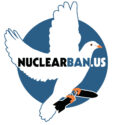For colleges and universities, being in Alignment with the Nuclear Ban Treaty means:
- Not undertaking any research that supports the maintenance or upgrading of nuclear weapons.
- Not holding any investments in any of the nuclear weapons companies.
- Deciding not to buy any of their products or services in future – unless they stop making nuclear weapons.
Before a college or university is likely to take the first step, there will almost certainly need to be student and/or faculty group that is committed to pushing this through. It may take nothing more than a single letter to the President or Dean of the college, it may take many meetings and letters with other key officials, and it may take a concerted effort among students and faculty to raise this issue to an appropriate level where it can be taken seriously. Please refer to our resource page for information on how to get started.
Once an institution is ready to move on this issue, there are 3 basic steps to Treaty Alignment:
- DECIDE to go through the process of becoming Treaty Aligned. This will require, at a minimum, a careful evaluation of what is involved and a formal decision by a President or a Governing Board to proceed to step 2.
- DISCONNECT from the nuclear weapons companies – to the extent that the university is able. Once the governing body of an institution of higher education has decided it wants to be Treaty Aligned, it will probably need to appoint a committee to look into its investments, contracts, research, and other possible connections. This committee with come up with a plan for becoming Treaty Aligned.
- DECLARE. The final step is a formal (and published) policy statement that clearly commits the college/university to adhering, as far as it is able, to the provisions of the Nuclear Ban Treaty. This must be made public and continued to be monitored by a committee of some kind.
Colleges and universities who choose to become Treaty Compliant are then invited to ‘take it to the next level’ by sharing what you have done:
- with other institutions of higher education.
- with national academic and professional research bodies.
- with the city and state within which you are located.
